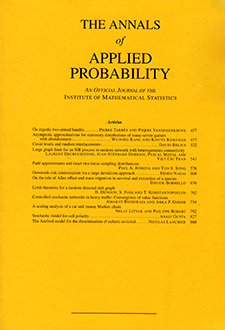Abstract
When making probabilistic models for survival times, one should consider the fact that individuals are heterogeneous. The observed changes in population intensities (or hazard rates) over time are a mixed result of two influences: on the one hand, the actual changes in the individual hazards, and, on the other hand, the selection due to high-risk individuals leaving the risk group early. I will consider the common multiplicative model for heterogeneity, but with the new feature that the random proportionality factor has a compound Poisson distribution. This distribution is studied in some detail. It is pointed out how its application to the survival situation extends a model of Hougaard, inheriting several nice properties. One important feature of the model is that it yields a subgroup of zero susceptibility, which "survives forever." This is a relevant model in medicine and demography. Two examples are given where the model is fitted to data concerning marriage rates and fertility.
Citation
Odd O. Aalen. "Modelling Heterogeneity in Survival Analysis by the Compound Poisson Distribution." Ann. Appl. Probab. 2 (4) 951 - 972, November, 1992. https://doi.org/10.1214/aoap/1177005583
Information





